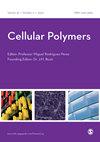研究了N2作为发泡剂在热塑性聚氨酯泡沫制造中的作用和影响
IF 1.3
4区 医学
Q4 MATERIALS SCIENCE, BIOMATERIALS
引用次数: 0
摘要
由于泡沫收缩,制造具有均匀孔结构的低密度弹性体泡沫一直具有挑战性。弹性体的低模量和发泡剂的高扩散率导致泡沫收缩和表面质量差。使用n2作为物理发泡剂(PBA)是一种克服泡沫收缩的环保发泡方法。本研究以硬度为85A、90A和95A的PTMEG-MDI/ bd基TPU为材料,采用n2发泡。以氮气为发泡剂制备的晶胞结构均匀,膨胀率在5倍以上,平均晶胞尺寸小于25 μm,晶胞密度大于109 cells/ cm3。比较了CO 2和N 2吹制的TPU泡沫在最大膨胀比下的收缩率和细胞形态。在最大膨胀比下,氮气吹制的泡沫具有良好的孔状结构,收缩率小于4%。而co2吹制的TPU泡沫的收缩率为12.7%,试样中有明显的裂纹。结果表明,以n2为发泡剂可获得与co2吹制泡沫相似的膨胀比,可显著消除弹性体泡沫的收缩问题,有利于保持泡沫的物理性能。本文章由计算机程序翻译,如有差异,请以英文原文为准。
Investigating the role and impact of N2 as a blowing agent in the fabrication of thermoplastic polyurethane foams
Fabricating low-density elastomeric foams with a homogenous cell structure has been challenging because of foam shrinkage. The low modulus of the elastomers and the high diffusivity of blowing agents lead to foam shrinkage and poor surface quality. Using N 2 as a physical blowing agent (PBA) is an eco-friendly foaming method to overcome foam shrinkage. In this study, PTMEG-MDI/BD-based TPU with a hardness of 85A, 90A, and 95A were foamed using N 2 . Nitrogen as a blowing agent created a homogeneous cell structure with an expansion ratio of more than five times, an average cell size of less than 25 μm, and a cell density of more than 10 9 cells/cm 3 . The shrinkage ratio and cellular morphology of CO 2 - and N 2 -blown TPU foam were compared at their maximum expansion ratio. At the maximum expansion ratio, the N 2 -blown foams exhibited a fine cell structure with a shrinkage ratio of less than 4%. However, the CO 2 -blown TPU foam showed a shrinkage ratio of 12.7% with significant cracks in the sample. The results demonstrate that using N 2 as a blowing agent can achieve an expansion ratio similar to that of CO 2 -blown foam, and the shrinkage problems of elastomeric foams can be significantly eliminated, which may help to maintain the physical properties of the foam.
求助全文
通过发布文献求助,成功后即可免费获取论文全文。
去求助
来源期刊

Cellular Polymers
工程技术-材料科学:生物材料
CiteScore
3.10
自引率
0.00%
发文量
9
审稿时长
3 months
期刊介绍:
Cellular Polymers is concerned primarily with the science of foamed materials, the technology and state of the art for processing and fabricating, the engineering techniques and principles of the machines used to produce them economically, and their applications in varied and wide ranging uses where they are making an increasingly valuable contribution.
Potential problems for the industry are also covered, including fire performance of materials, CFC-replacement technology, recycling and environmental legislation. Reviews of technical and commercial advances in the manufacturing and application technologies are also included.
Cellular Polymers covers these and other related topics and also pays particular attention to the ways in which the science and technology of cellular polymers is being developed throughout the world.
 求助内容:
求助内容: 应助结果提醒方式:
应助结果提醒方式:


